What Is Dan Harmon’s Story Circle?
- The vertical line down the middle represents the character’s internal change.
- The horizontal line across the middle represents the character’s external change.
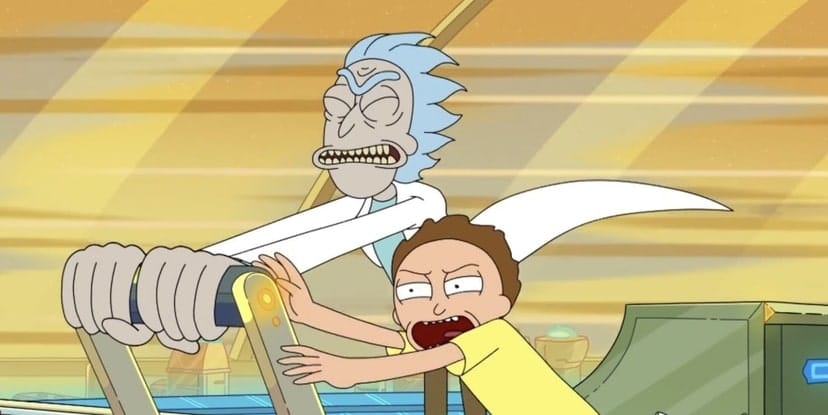
How Dan Harmon’s Story Circle Works
The right side of the vertical line represents a balance of order or a state of equilibrium, where the character is stuck in the normal world and has yet to face the change. The left side of the vertical line represents a character’s changing transformation. Entering out of the normal world into the special world.
The top half of the horizontal line represents a state of order, where everything is in control within the hands of the protagonist. The bottom half of the horizontal line represents a state of chaos, where the extraordinary world brings unknown trials that will challenge the protagonist and test their strengths and weaknesses.
Crossing the bottom half of the circle represents the character change, where the protagonist leaves their special world in a completely different position and state to when they entered that new world. They face new revelations and observe their new selves.
When the first threshold is crossed the character loses. When the second threshold is crossed, they will have learnt enough to beat the antagonist.
The 8 Steps to Dan Harmon’s Story Circle
Dan Harmon’s Story Circle has 8 steps. Each step changes the direction and course of the protagonist‘s journey.
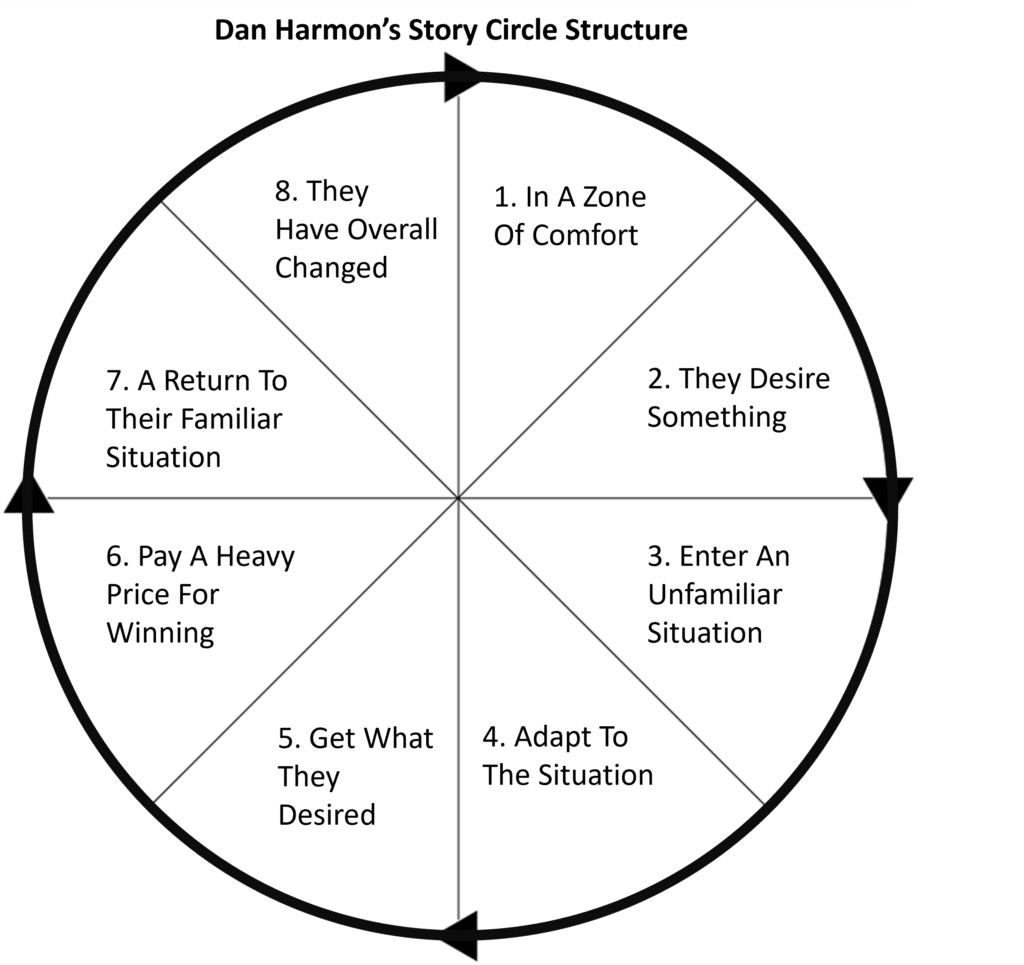
The Story Circle’s 8 Steps:
- In A Zone of Comfort
- They Desire Something
- Enter An Unfamiliar Situation
- Adapt to The Situation
- Get What They Desired
- Pay a Heavy Price for Winning
- A Return to Their Familiar Situation
- They Have Overall Changed
The Steps Explained
1. In A Zone Of Comfort
In the first step, the protagonist is surrounded by a world known to them, where they are in control of their situation. This world is unchallenging and the protagonist lives a relatively mundane everyday.
2. They Desire Something
The protagonist really wants something. They want to achieve this goal so bad they will go to great lengths to achieve it. However, this desire is out of their reach and throws them out of their comfort zone.
3. Enter An Unfamiliar Situation
In order to achieve this goal or desire the protagonist has to enter unknown territory. They are thrown into a world beyond their control.
4. Adapt To The Situation
The protagonist combines their already established skills with their newly acquired skills to fully adapt to their new surroundings. However, this takes time which can lead to trouble as time is never on their side.
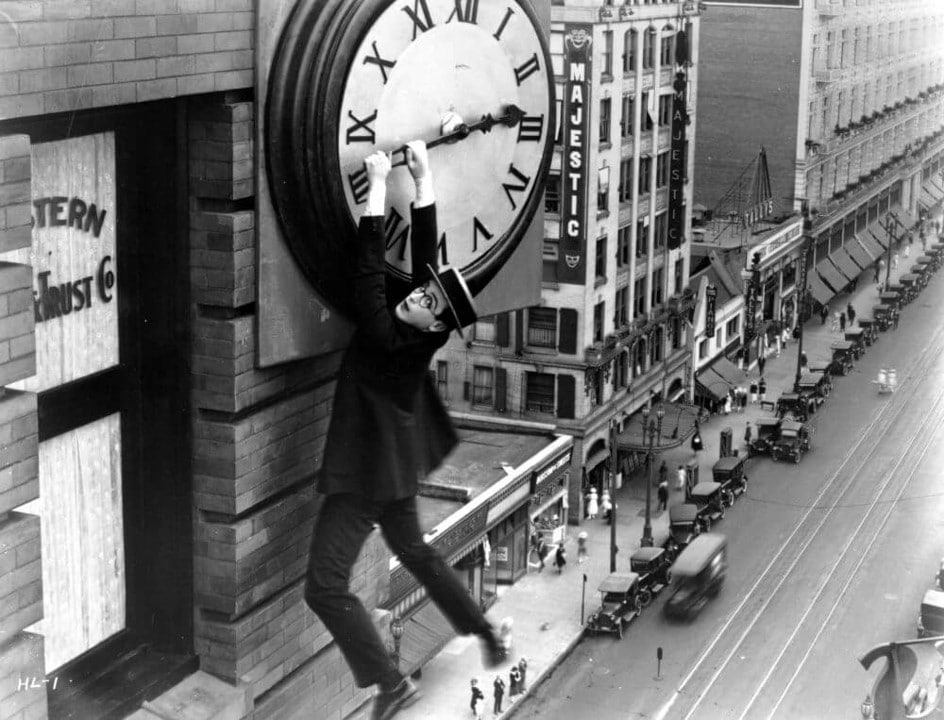
5. Get What They Desired
The one thing they truly wanted is gained but other obstacles follow close behind.
6. Pay A Heavy Price For Winning
When things go too well bad things start to happen. The protagonist wins something but loses another thing. Something important or meaningful to the protagonist has been lost.
7. A Return To Their Familiar Situation
The protagonist returns to their normal world. As a result, they ease back into their zone of comfort, where everything is familiar again.
8. They Have Overall Changed
However, after entering back into their familiar world, the protagonist does not return as the same person. A deep-rooted trait has changed inside them, whether that be a fear they have overcome or a character flaw that they have changed. Although, by the end of the journey the character’s everyday life has been enriched by their experience.
The character can start the circle again and follow the same process. For example, in The Harry Potter franchise, Harry wants something and enters a new world and has to overcome his obstacles in each of the movies, whilst meeting allies and enemies along the journey.
Character Arcs
Character arcs in TV Show characters will follow this story circle more in each episode. The character will find themselves in an unfamiliar place or situation and The Story Circle process will start up again in each episode.
The beginning and ending of The Story Circle are the shortest stages, with the lower half of the circle containing the most important steps on the journey.

Dan Harmon’s Story Circle tends to be symmetrical. As opposite sides of the circle correspond with the steps.
- For example, Step 2 – where the character desires something is directly opposite to Step 6 – where the character has to pay a heavy price for gaining what they desperately desired.
The Story Circle can be applied to other areas of development too – from sub-plot development to side-characters, not just the protagonist’s story. All characters in the story can have a story circle in their journey arc, from main characters to minor characters. The story always changes direction when the character crosses the first and second thresholds.
Movie Examples Using Dan Harmon’s Story Circle
Dan Harmon’s Story Circle can be applied to stories in different genres. Below we will look at three examples of movies from different genres – romance, family and action – using the Story Circle as analysis.
Movie Analysis Example 1 – While You Were Sleeping (1995)
Genre: Romantic Comedy
Movie Logline: A hopelessly romantic Chicago Transit Authority token collector is mistaken for the fiancée of a coma patient.
Protagonist: Lucy Eleanor Moderatz
Dan Harmon’s Story Circle Analysis:
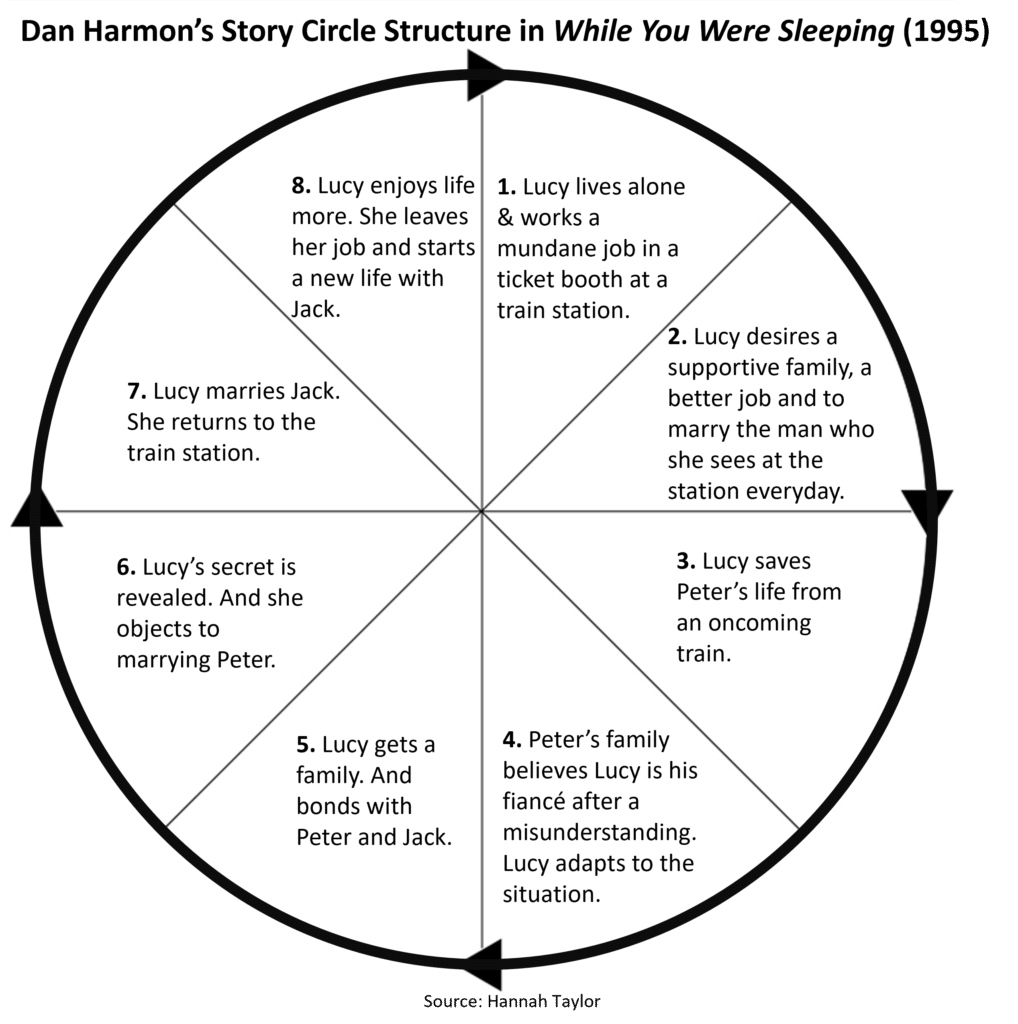
First Half of The Story Circle
1. Lucy is in a zone of comfort where she lives a mundane life, working at a ticket booth in a train station. She lives alone in an apartment and doesn’t have many people in her life.
2. Lucy really likes the man who goes through the ticket barrier every day. She wishes she could marry him. She overall has three main desires – to have a supportive family to spend time with, to get a better job which she enjoys and to be with the man of her dreams.
3. One day, the man Lucy fantasises about, Peter, is physically assaulted on the platform and hits his head on the railway tracks. Lucy helps him survive an oncoming train.
4. Lucy visits Peter in the hospital. After a misunderstanding, Peter’s whole family comes to believe Lucy is Peter’s fiancé. Lucy goes with it and adapts to this big lie as her new life.
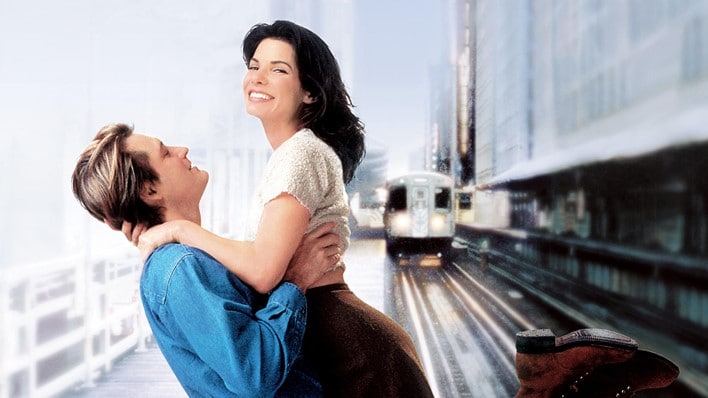
Second Half of The Story Circle
5. Lucy gains a family-orientated life. As she doesn’t have any family members alive, the Callaghan family invite her in as one of their own. Lucy enjoys Christmas with them and is given a present along with a stocking on their mantelpiece, as a visual take on her newly-found status as a family member.
However, Lucy finds similar ground with Peter’s brother, Jack and she is said to be more his type. Her desire somewhat changes naturally, as Peter is in a coma, Jack and Lucy develop a stronger bond based on the situation and their things in common.
6. Lucy pays a heavy price as she is torn between the brothers. She thought she knew what she wanted all along and that was Peter. Until Jack changes the direction of the wheel. And slowly Lucy’s big secret is becoming less and less plausible. Attempt after attempt, Lucy tries to tell the family but there is never a perfect moment.
7. Lucy objects to marrying Peter and the secret is out. Lucy is back in her apartment, alone again. Just like at the beginning as if nothing has changed. She goes back to working at the train station. Until Jack proposes.
8. Lucy marries Jack and they travel into the distance on the train together. The train ironically leaves the same platform where Lucy’s ordeal begun. The story begins and ends in the same place. Lucy’s personality has not changed but over the course of her journey, her career status and relationship status have changed considerably.
She goes from working in a job she hates and wishes to be with the man she likes to ending up quitting her job and marrying the one she should really be with. A fairy-tale happy ending for the protagonist.
Movie Analysis Example 2 – The Cat in the Hat (2003)
Genre: Family Comedy-Adventure.
Movie Logline: Two bored children have their lives turned upside down when a talking cat comes to visit them.
Protagonists: Sally and Conrad Walden
Dan Harmon’s Story Circle Analysis:

First Half of The Story Circle
1. The characters begin in an area of familiarity where, Conrad is a troublemaker and Sally is the goody-two-shoes. The mother, Joan, works for a highly agitated germaphobe boss.
2. The two main protagonists, Sally and Conrad, both desire different things that result in the same ending. They both want more fun where it’s raining outside. So they have to stay inside and there is nothing in the house for them to do. Sally wants to be more spontaneous. Conrad wants an adventure.
However, their mother, Jean, is hosting a party for her colleagues but her boss threatens to fire her if the house is messy. She desires her house to be clean, to keep her job and for her kids to behave. She states one rule, for the children to “not step foot in the living room or else”.
3. Characters enter an unfamiliar situation – “The Cat” turns up in their house. They try to hide. And then go against their mother’s rules and wishes by going in the living room, ruining the house and making it messy for the party.
4. Conrad and Sally sign a contract to go on the adventure. They follow the Cat’s lead.
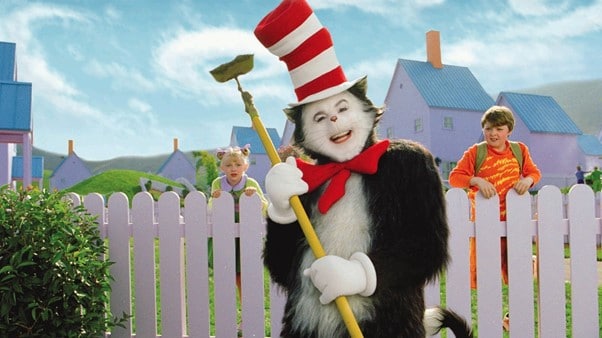
Second Half of The Story Circle
5. Conrad and Sally go on an adventure to find the lock to ‘The Mother of All Messes’ box.
6. Thing 1 and Thing 2 ruin the house. The Mother of All Messes box is opened. The house is a huge mess. And Sally and Conrad contemplate telling their mother the truth.
7. The Cat cleans the house, reversing his mess. The house goes back to normal. Everything is the same again when mum Joan returns home.
8. Sally and Conrad change. They are more fun and enjoy things more. Also, they have formed a tighter bond as siblings and with their mother. Joan returns home, pleased with the look of the house and her boss approves.
The last shot shows the family jumping on the sofa in the living room, suggesting they have all learnt to become more carefree. The Mum, Joan, reverses her own rules and becomes more free herself. She also comes to realise that Larry, her next-door neighbour who likes her, but dislikes the children, is a fraud and she eventually comes to her senses.
All three characters change and have their own transformation arc, particularly, the children as the Cat has taught them to have more fun among the mundane and everyday.
Movie Analysis Example 3 – Taken (2008)
Genre: Action Crime-Thriller
Movie Logline: A retired CIA agent travels across Europe and relies on his old skills to save his estranged daughter, who has been kidnapped while on a trip to Paris.
Protagonist: Bryan Mills
Dan Harmon’s Story Circle Analysis:
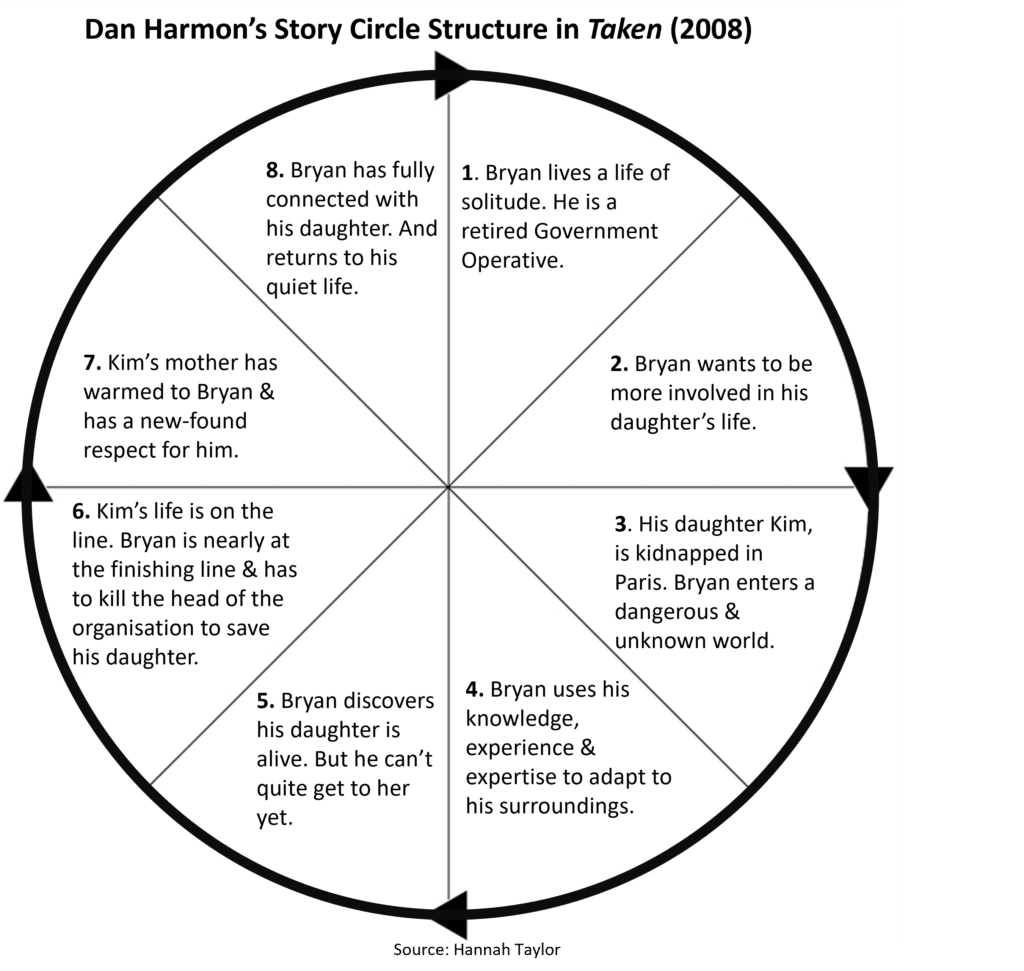
First Half of The Story Circle
1. Familiarity – The film opens with the protagonist, Bryan, buying a present for his daughter, Kim’s seventeenth birthday party. Bryan knows she wants to be a singer and buys her a karaoke machine. Her stepfather competes with him and buys her a pony.
Bryan has a strained relationship with Kim’s mother and stepfather. He lives a life of solitude as a retired Government Operative. The audience learns his ways as he prefers to know background information on people he meets and is always careful. However, his daughter, Kim is the exact opposite. She is oblivious to the real world and is carefree in her nature.
2. Bryan wants to be closer to his daughter and wishes to see her more often. He was away from Kim’s life for a long time because of his job and is finally trying to reconnect with her. As a favour for his friends, Bryan takes on a Security Job for a popular singer, whom his daughter is a fan of.
Bryan proves his skills and can clearly handle himself when a concert situation gets out of hand. He earns the trust of the singer.
3. Kim goes to Paris with her friend. It’s out of Bryan’s control. His rules and conditions are thrown out the window. Bryan has tried to always know Kim’s whereabouts. He is thrown into an unknown world, where he fears the unknown.
He’s left in the dark and knows less information than he wishes to know. Kim is taken. Bryan’s new goal is to find his daughter within an underworld of drug lords and trafficking.
4. Bryan adapts back to his old ways of investigating and uses his knowledge to enter into their new world.
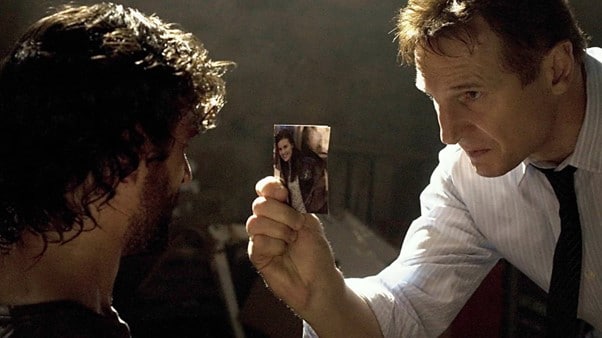
Second Half of The Story Circle
5. Bryan edges closer to what he wants. But each step is only one small step in a big place. He’s so near yet so far when he finally sees his daughter at a bidding war amongst high-paying clientele.
6. But in order to get there, he has to go through a series of fights and dangerous challenges. This displays the size and power of the organization from the sheer volume of men, Bryan has to get past in order to find Kim.
7. Bryan finally gets to the head of the organization. He gets his daughter back and the family dynamic has slightly changed. The mother and her new husband seem to warm to Bryan more and have a newfound respect for him.
8. Bryan has fully connected with his daughter. And particularly, after suffering this whole ordeal together has strengthened their bond. Especially, because Kim and Bryan were the only two to see the horror of the trafficking business and have both learnt the dangers.
They have connected on a whole new level and shared an experience together that Kim is unable to share with anyone else.
In Conclusion
Movies in different genres can follow Dan Harmon’s Story Circle structure, as the above examples demonstrate. Genres from Comedy Romance Drama in While You Were Sleeping to Comedy Family Adventure in The Cat in the Hat and Crime, Thriller and Action in Taken. These are just a few examples of genre-specific movies that can fit the steps within the circle.
Ultimately, the protagonist is taken on this journey because something in their life needs to change. Their goal spurns them on in this change and they learn from the experience, using their journey as a way to transform the mundane familiar world into a world they can better understand.
Dan Harmon’s Story Circle lays this out in very clear terms. It’s all about taking the protagonist on a clear journey and the steps in that journey being discernible. By framing these steps in a circle, the pattern becomes obvious. Journeys are typically circular after all, ebbing and flowing rather than following a strict linear line. And the story circle is a helpful visualisation of this.
In terms of structural techniques to follow, there are many different ways to skin a cat. And all can be helpful in clarifying a path for you to follow writing your screenplay. Adhering to the rules without any wriggle room isn’t necessarily the point. But having clear beats to follow is always a surefire way to give your story solidity.
Enjoyed reading about Dan Harmon’s Story Circle? Check out some more of his wisdom in 15 Awesome Dan Harmon Quotes for screenwriters.
In Summary
Dan Harmon’s Story Circle is a narrative structure to follow for writing a screenplay. There are 8 steps, broken down into different stages of the protagonist‘s journey through the story and the extent of the change enacted upon them throughout.
2. They Desire Something – The character has a goal they will go to great lengths to achieve.
3. Enter An Unfamiliar Situation – They are thrown into a world of the unknown.
4. Adapt to The Situation – The protagonist adapts by blending their knowledge with their newly acquired skills.
5. They Get What They Desired – Their ultimate goal is accomplished but the finishing line is nowhere near.
6. They Pay a Heavy Price for Winning – They lose something important to them, which sets them back further.
7. A Return to Their Familiar Situation – The protagonist goes back to their normal world but they are a completely different person from the start of their journey.
8. They have Overall Changed – The protagonist uses their experience to enrich their new lives back in the familiar world.
– What did you think of this article? Share It, Like It, give it a rating, and let us know your thoughts in the comments box further down…
– Struggling with a script or book? Story analysis is what we do, all day, every day… check out our range of script coverage services for writers & filmmakers.
This article was written by Hannah Taylor and edited by IS Staff.
Get *ALL* our FREE Resources
Tackle the trickiest areas of screenwriting with our exclusive eBooks. Get all our FREE resources when you join 60,000 filmmakers on our mailing list!


TrUly Gold. How Can I Access The Article And Download It For Futhere Exploration.!
girl wtf r talking about this is the goddamn heros journey, so ridiculous to portray this “story circle” of dan harmons as something unique
Hello.
How would the would the circle be for the movie Inception?